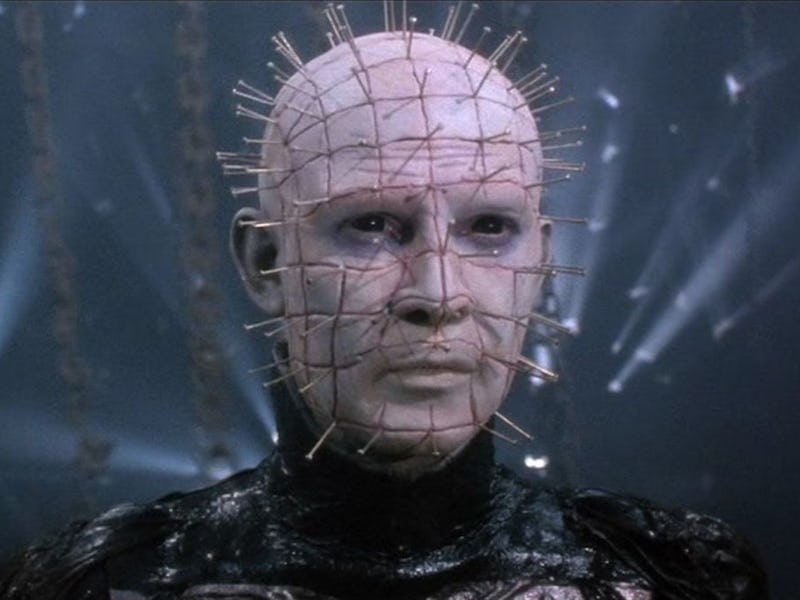The First Hellrasier Sequel Turned a Personal Artistic Vision Into a Viable Franchise
We have such profits to show you.

Clive Barker’s Hellraiser is such an idiosyncratic work of art that it’s astonishing it launched a long-running franchise. There’s almost nothing in Barker’s BDSM-fueled vision of horror that suggests a string of sequels and a secure place in mainstream pop culture, and even as the movie became a box-office success, it didn’t seem like it could lead to an open-ended series in the vein of other lucrative 1980s horror properties.
It’s really its first sequel, Hellbound: Hellraiser II, that provided the foundation for the franchise to continue. With Barker credited with the story and as a producer, director Tony Randel and screenwriter Peter Atkins expanded on his initial vision to incorporate it into a more conventional horror-movie structure. Hellbound is still infused with kinky sexuality, but it also sets up a more clearly defined mythology that can be adapted into future films, providing actively evil intent for the demonic Cenobites.
That includes Pinhead (Doug Bradley), the breakout character who became the face of the franchise, but who had a relatively minor presence in the first movie. He still isn’t the main antagonist, but he gets more lines and screentime, and is listed in the credits for the first time by his popular nickname, despite it not being used in the film. Bradley even gets to appear without his Pinhead makeup in an opening prologue that expands on the Cenobites’ backstory. Bradley’s military officer opens the familiar puzzle box known as the Lament Configuration and is drawn into Hell, where he’s transformed into the spiky-domed demon viewers recognize.
Barker and Atkins don’t go much deeper into the Cenobites’ origin story, but it’s enough to suggest a vast history that reaches beyond the experience of returning protagonist Kirsty Cotton (Ashley Laurence). Kirsty begins Hellbound in the place where many horror-movie final girls find themselves if they return for a sequel: a mental institution. She helpfully recaps the first movie’s plot for the doctors attending her, and her stories of demons and resurrections are received with skepticism, especially by the requisite hard-boiled cop investigating the demise of her family members.
Kirsty begins Hellbound in a mental institution, and it only gets worse from there.
While Hellraiser focused mainly on the depraved desires of Kirsty’s uncle Frank (Sean Chapman), Hellbound elevates stepmother Julia (Clare Higgins) to the position of main sicko, brought back from the dead in much the same way Frank was in the original. Like Frank, Julia uses twisted sexuality to get what she wants, although it doesn’t take much coercion for her to recruit Dr. Phillip Channard (Kenneth Cranham), who runs the facility where Kirsty is being held. He turns out to be a bit of a Cenobite connoisseur, and he engineers the circumstances for a skinless Julia to emerge from a blood-soaked mattress left behind in the Cotton house.
The first half of Hellbound offers a streamlined version of Hellraiser’s central Frank/Julia dynamic, as Kirsty is desperate to get out of the hospital and stop her evil stepmother from returning. She’s also convinced she can rescue her father, Larry (played by Andrew Robinson in the first movie), whom she believes has been trapped in Hell. As entertaining as it is to watch the bizarre courtship between Julia and Channard, what really sets Hellbound apart is when it literally goes to Hell in its second half.
Dr. Channard turns out to be a Cenobite fanboy.
After Channard gets one of his patients, mute teenager Tiffany (Imogen Boorman), to open the Lament Configuration, he and Julia follow the Cenobites into Hell, with Kirsty and Tiffany close behind. With a larger budget than Barker had, Randel creates a surreal, M.C. Escher-influenced hellscape that’s a marvel of production design, moving the action from the grimy mental institution and Channard’s pristine modernist home to a dank, labyrinthine dimension of hedonistic torture.
After their occasionally stilted acting in Hellraiser, both Laurence and Higgins give strong performances here, and Higgins especially relishes Julia’s turn as a full-on villain. Kirsty’s surviving boyfriend from the first movie is quickly written out, and her new male companion, Channard’s assistant Kyle MacRae (William Hope), proves spectacularly useless. The core of Hellbound is a showdown between these two women, strengthened in very different ways by their previous ordeal, ready to either conquer or vanquish the forces of Hell.
That puts Pinhead and his fellow Cenobites on the sidelines, which is also where they’ll end up in the inferior later films. But it may be right where they belong, as beings who unlock the human characters’ deepest, most deviant wishes, then let them reap the horrifying consequences. It’s easy to see how that could play out with different characters in different situations over the course of many more movies. Hellbound may be less personal than Barker’s original film, but it represents a more fully realized production, transforming those dark inner demons into something more recognizably horrific.